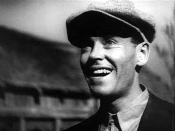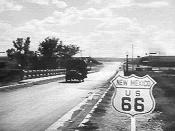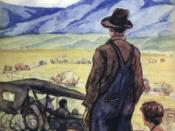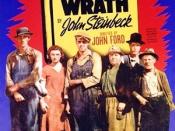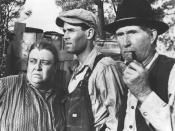Masculinity is a well known stereotype that often defines men as being tough, strong, and having no emotions. In most cases, their work tends to identify their level of masculinity. In The Grapes of Wrath by John Steinbeck, The Great Gatsby by Scott F. Fitzgerald, and The Glass Menagerie by Tennessee Williams, the male characters create their identities through their abilities to provide for their families. In these three texts, the males portray their masculinity by their roles as head of the family and their work and wealth.
As a tradition in many cultures, the males assume the position as head of the family. In most cases, their family responsibilities and obligations establish their masculinity. ÃÂPa was the head of the family nowÃÂ (Steinbeck 139). In The Grapes of Wrath by John Steinbeck, Pa became the leader of the family after Grandpa died. Pa took over GrandpaÃÂs role in the family and was responsible for the whole family in result.
Traditionally, the position of the family leader is passed down to the eldest male. Similar to Pa in The Grapes of Wrath, Tom in The Glass Menagerie by Tennessee Williams, demonstrated his masculinity as the head of the household after his father had abandoned the family. ÃÂI mean that as soon as Laura has got somebody to take care of her, married, a home of her own, independent -- Why, then youÃÂll be free to go wherever you please, on land, on sea, whichever way the wind blows you!ÃÂ (Williams 35). Tom is obligated to support his family, especially his crippled sister Laura, until she finds a husband. Because Tom was the only male in his sister and motherÃÂs lives, he had to assume household responsibilities, as most men did for their families. Ultimately, Pa and Tom expose their masculinity by obtaining the duties of being in charge of their families.
Customarily, a manÃÂs masculinity is defined through his wealth, occupation, or means of work. Throughout society, it is a stereotype that if a man makes a sufficient amount of money and has a job that easily supports himself and or his family, he is masculine. If he has a small, not so important, low earning job, then he is typically considered less masculine. In The Grapes of Wrath, Pa struggles to prove his masculinity. ÃÂWell what the hell am I gonna do? WeÃÂre out of money. One of my boys got a short job but that wonÃÂt feed us.ÃÂ (Steinbeck 374). Pa gets frustrated because heÃÂs helpless when it comes to work. He does not feel like he is supporting his family, therefore he feels like he is masculinity is diminishing. Different from Pa, Tom and Gatsby in The Great Gatsby are able to successfully display their masculinity by the amount of wealth that they have. Tom BuchananÃÂs arrogance and pride that he shows toward his wealth seems to prove his masculinity to his mistress Myrtle. They are both hung up on his money and Tom likes to flaunt it. Because Tom is wealthy, Myrtle sees him as the perfect gentleman. ÃÂTwo shining arrogant eyes had established dominance over his faceÃÂ (Fitzgerald 7). Tom is described as being clearly aware of his power and manliness. Like Tom, Jay Gatsby also has a large fortune. The fact that Mr. GatsbyÃÂs money is entirely earned from work, unlike Tom whose money is passed down through the family, also displays masculinity. His gorgeous home and lavish parties provided by his abundant wealth makes the community realize how much he earns, which otherwise depicts his masculinity.
Masculinity is identified in The Grapes of Wrath by John Steinbeck, The Great Gatsby by Scott F. Fitzgerald, and The Glass Menagerie by Tennessee Williams, through the male charactersÃÂ abilities to support their families, which also touches upon their jobs and wealth. In modern society, while masculinity still seems to be based on a manÃÂs ability to provide for his family, the type of job he has, or the money that he earns, it plays a crucial and distinctive role in the way that people view men. Overall, it classifies their level of manliness. Furthermore, men tend to strive to gain these qualities that illustrate masculinity, as it is portrayed in these three novels.
